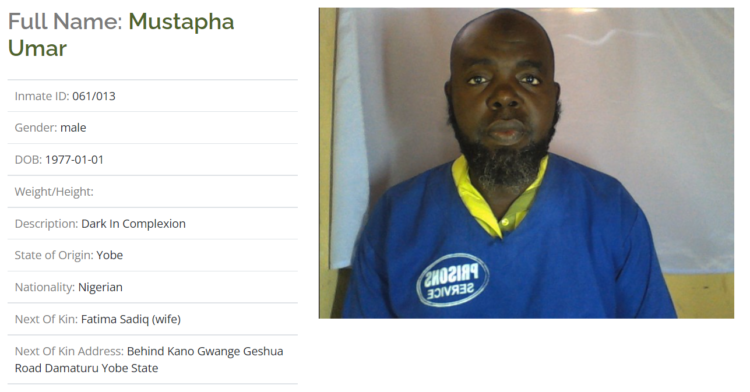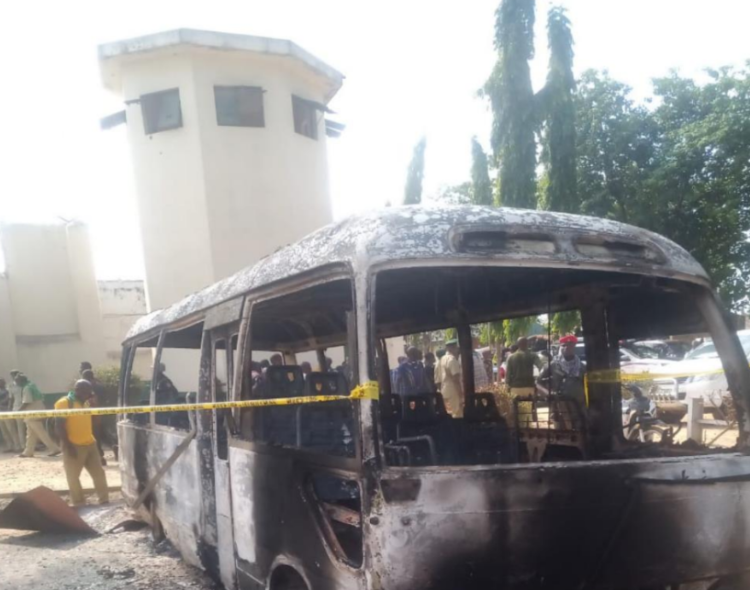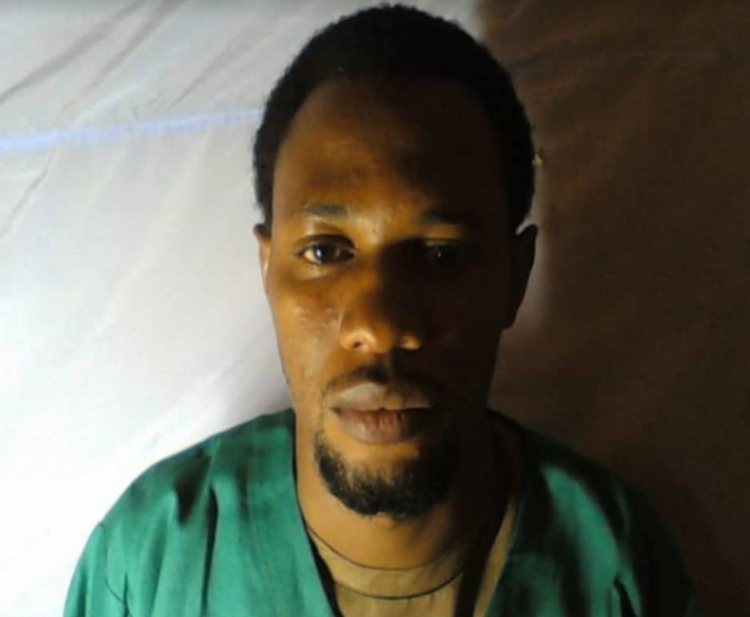In the security circle, the prison is described as a “self-sustained defended” facility with some resources to thwart attacks. But the vigil of armed personnel there had slipped into a groove in which they usually lowered their guard.
So, with a chill in the air one night in July, they were relaxed, unprepared for the coming danger despite the intelligence available to their office-based superiors warning of an attack. Suddenly, they heard a loud bang, then sounds of gunfire, pitching them into turmoil and panic.
Disoriented, having not prepared, they fled, making the attackers advance and ultimately deliver a successful operation barely challenged.
Terrorists attacked the Kuje Medium Security Correctional Centre in Nigeria’s Federal Capital Territory on 5 July with a cocktail of Improvised Explosive Devices and high-calibre weapons to free imprisoned fighters.
ISIS-aligned Islamic State West Africa Province (ISWAP) claimed the attack, which intelligence sources and researchers familiar with the terror group’s setup said was carried out by the group’s Kogi cell fighters, aided by another terror group, Ansaru. A total of 879 of the 994 inmates escaped, and more than 400, including over 50 terrorists, remain at large, according to internal records.
Ansaru, or Ansaru al-Musulmina fi Bilad al-Sudan, headquartered in Kaduna’s Birnin Gwari area, is an Al Qaeda-aligned terrorist group that broke away from Boko Haram, or Jama’atu Ahl al-Sunna lid Da’wati wa al-Jihad (JAS), in 2012 following disagreements with leader Abubakar Shekau over methods and targets.
According to intelligence reports and human sources consulted for this investigation, terrorists that formed Ansaru were responsible for some of the high-profile attacks – including the August 2011 UN building bombing – claimed by Boko Haram before the split.
ISWAP similarly broke away from Boko Haram in 2016.
On the night of the Kuje attack, 65 armed personnel were on guard duty. They included 31 military personnel of the Nigerian Army from the 176 Special Forces Guards Brigade Battalion, Gwagwalada, five personnel of MOPOL 21, and five personnel of MOPOL 50.
Others were two personnel of the counter-terrorism unit of the Nigeria police, two personnel of the Kuje police division, seven personnel of the Nigeria Immigration Service, three personnel of Nigeria Security and Civil Defence Corps (NSCDC), and 10 personnel of the correctional service armed squad. One civil defence officer lost his life to gunfire.
In the wake of the attack, 47 kilometres to the Aso Rock Presidential Villa, and 24 kilometres to the Nnamdi Azikiwe International Airport, President Muhammadu Buhari publicly expressed disappointment and demanded a “comprehensive” report.
He said, “How did the defences at the prison fail to prevent the attack? How many inmates were in the facility? How many of them can you account for? How many personnel did you have on duty? How many of them were armed? Were there guards on the watchtower? What did they do? Does the CCTV work?
“I am disappointed with the intelligence system. How can terrorists organise, have weapons, attack a security installation and get away with it?”
Almost three months after, the Buhari government is yet to fully account for the attack and the public remains worried about the country’s vulnerability after the attack, which pumped dangerous criminals back into society.
However, PREMIUM TIMES’ investigation – based on leaked “secret” records, interviews with a man on guard duty, security sources, and Kuje residents, analyses of experts we described our findings to, and exclusive official disclosure – has found flaws in Nigeria’s security preparedness and armed response capacity, which made the attack successful.
A rare collaboration of ISWAP and Ansaru delivered the attack, expert terrorism researchers with knowledge of the working of the terror groups and those tracking the escaped terrorists told PREMIUM TIMES. According to these sources, Ansaru, whose fighters were also held in Kuje, did the reconnaissance and intelligence gathering work around Kuje but had no logistical capability to carry out the attack.
After an initial operational disagreement over ideological rivalries, Ansaru then left the attack for ISWAP, whose Shura Council committed to freeing all terrorists, belonging to ISWAP, Ansaru, and JAS. ISWAP was said to have deployed more fighters from their ‘Timbuktu’ base in the dreaded Alagarno area of Damboa LGA, Borno and Lake Chad islands to join their Kogi cell fighters.
While the fighters were hibernating in the communities around the prison and plotting to strike, the Nigerian security and intelligence setup did not obtain any useful intelligence, fast enough to prevent the attack.
But several hours before the attack, the secret service, SSS, warned of a possible terrorist act, officials familiar with the transmission told PREMIUM TIMES. Despite the availability of such intelligence, which should have caused heightened preparation and proactive measures, the attack happened and the armed personnel on the direct defence line were not briefed.
The spokesperson for the correctional service, Abubakar Umar, told this investigation that the intelligence was “general”.
“Intelligence gathering involves multiple agencies and as of the time the information got to us it was as a piece of general information and it happened, unfortunately, Kuje was attacked,” Mr Umar said, appearing to explain that there was no warning specifically that Kuje would be attacked.
But superior correctional officials and intelligence sources, interviewed for this investigation, said the warning was specific. Three senior correctional officials, who asked not to be identified by name for job security, separately explained that the “poor,” “bureaucratic,” and “slow” process of managing and distributing intelligence was a problem.
“The correctional service did not directly receive intelligence,” one of the officials said. “It passed through various desks and there was never prompt passage whereas the quality of useful intelligence in such circumstance is timeliness. By the time it got to us, it was already late, too late to prepare the armed men on the ground.”
SSS’ spokesperson Peter Afunanya did not honour a request for an interview to comment on our findings relating to intelligence management.
Another official blamed the “superiority complex” and “rivalry” among security agencies and their chiefs for intelligence failure.
“Then, The CG (Controller-General of the correctional service) has to be included in the security council meetings and intelligence concerning the service has to be directly passed to the service quickly because the service is important in the national security system,” the source said.
“But after the Kuje attack and with everybody knowing what went wrong, we now have intelligence directly, quickly. That has helped our proactiveness and helped to prevent further attacks, including in Nasarawa State, without people in the public knowing.”
But even more worrying, PREMIUM TIMES’ investigation found that months before the 5 July attack, an inmate, Umar Ladan, from Borno, also called ‘Maikifi’, had “boasted about the attack many times,” according to a leaked “secret” record of incidence assessment carried out by the intel service. The record cited “multiple sources” including recaptured inmates.
The record described Maikifi, 39, as a terrorist. He remains at large according to the correctional service.
In addition, PREMIUM TIMES’ investigation revealed that an inmate, Mustapha Umar, 45, from Yobe State, was the extremist leader in Kuje prison and was using an Android phone with which he was communicating with the fighters outside.
Mr Umar, who is now at large, was said to have led the radicalisation of some other inmates in Kuje.

Photo: Mustapha Umar, Kuje prison terrorist leader using Android phone. He remains at large. (Source) NCoS website)
“Through the phone, they (terrorists outside the prison) were sending him radical sermons and literature to strengthen his faith and they kept reassuring they would come to rescue him and others,” one source said, describing findings from their tracking escaped terrorists.
They said many of the escapees, including those converted in the prison, exited Nigeria through Katsina and “passed through the Niger Republic before re-entering Nigeria through Lake Chad to join ISWAP on the islands.”

Photo: Watch tower in the background. If it had been used, it would have given defenders a vantage position to lay down destructive defensive fire and force the terrorists to abandon their mission or get them disoriented. (Source: Leaked assessment record)
“Off side, off beat and off guard”
In an account obtained from a source, among the men guarding the prison, the attack started “(a) few minutes before 10 p.m.” when a loud bang was first heard from a side of the facility’s perimeter wall.
The sound had come from the detonation of a “massive” explosive charge on the outermost wall of the facility, which then caught the guards “off site, off beat, and off guard,” the assessment record said, corroborating our source’s account.
“The detonation disoriented and harassed the defenders, causing panic, ensuring that it quickly turned into every man for himself,” the record added.
As the guards, including soldiers, fled their positions, the terrorists took over the main gate, spending “more than thirty minutes” in an attempt to breach it but the gate held despite using explosives.
Then, they detonated more explosives at another gate – the haulage gate, normally for trucks supplying food – which fell, allowing them to enter the facility, according to the assessment record, exclusive official disclosure, and witness accounts.
The guards used sandbags and tin roof shacks as firing positions, a common defensive structure among Nigerian security formations, which experts say is not solid enough and does not afford defenders little confidence to stand ground against enemy fire.
Instead of sandbags, if the correctional service had prepared, they could have used outdated and unserviceable armoured tanks in the army’s mothballs.
“(Outdated) armoured tanks, dug in and placed around Custodial Centers will provide reinforced firing positions for defenders,” the assessment record said. Tanks are largely bomb and fireproof, giving defenders greater confidence to stand ground.”
In the moments immediately following their entrance, they precisely located their primary targets – Idris Ojo and Mohammed Sani, two awaiting trial inmates – and set them and others free. Messrs Ojo and Sani are ISWAP fighters from the terror group’s Kogi cell, researchers who have a working familiarity with the expansion of ISWAP and officials told PREMIUM TIMES. Mr Ojo has been recaptured, but he remains with the military.

Photo: Mohammed Sani, one of the primary targets of the attack, is an ISWAP terrorist. (Source: Intel sources)
Though severely hit in their original Borno base, ISWAP has created new cells in the Fufore forest area, from where they have struck in the neighbouring Taraba State at least thrice this year; in the Okene axis of Kogi State in central Nigeria where they also claimed two attacks this year; and Kano in the Northwest.
The May explosion in Kano was a bomb explosion at an ISWAP IEDs-making facility, security sources confirmed to PREMIUM TIMES, corroborated by residents and local journalists pressured to report a “gas explosion” instead.

Photo: Idris Ojo, one of the primary targets of the attack, a terrorist from the ISWAP’s Kogi axis cell. He has been recaptured (Source: Intel sources)
“Alien approach”
Spokesperson Mr Umar said the correctional service had gotten used to prison violence caused by “internal insurrection” but improved welfare of the inmates had removed that threat.
“But the method adopted by the Kuje attackers was alien to us,” Mr Umar said. “It was not internal insurrection but external using sophisticated weapons. Also, they were more than 300 and they used an element of surprise.”
“We don’t have enough manpower on the ground to face over 300 attackers with sophisticated weapons but our men still did a yeoman job in preventing the capture of Abba Kyari by the terrorists.”
While the guards were only AK-47-armed, the terrorists used automatic weapons like General Purpose Machine Guns and anti-aircraft guns as well as semi-automatic rifles such as AK-47s, in addition to explosives which they detonated multiple times.
However, Mr Umar’s point about the “alien” approach seems weak since a similar “external” force had previously attacked the Agodongbo prison facility in Oyo last October.
Like the Kuje attack, the Oyo attack was to free imprisoned criminals, sources, including officials, who witnessed the Oyo attack said.
Also, the assessment record that PREMIUM TIMES obtained said the claim that the Kuje attackers numbered over 300 “is highly likely an exaggeration to save face.”
“Several recaptured inmates had the numbers at between thirty to fifty ( 30-50 ). Regardless, the attackers most likely were in the region of a hundred ( 100 ),” the record said.
Then, the claim that “internal insurrection” had not contributed to the success of the attack is contradicted by the leaked assessment record we obtained.
“We equally assess that, the unprofessionalism of officers at the MSCC Kuje evidenced by the huge numbers of trafficked phones facilitated terrorists and inmates planning and implementation,” said the record.
The Kuje prison terror leader, Mr Umar, was using an Android phone facilitated by compromised prison officials, PREMIUM TIMES was told by sources tracking the escaped inmates.
Mr Umar told this investigation that it had not been established that any staffer aided the attack. “(There is) no intelligence that any officer collaborated to aid the attack but there are mechanisms in place to enforce standards and conduct expected of staff. People have been dismissed for misconduct,” he said.
Also, the awareness of terrorists’ desperation to free imprisoned fighters was present in the security circle, and that should have informed heightened preparedness at locations holding terrorists, like Kuje. Intelligence sources said the 28 March Abuja-Kaduna train attack in which terrorists abducted passengers was staged to force the government into a prisoner swap deal.
The Buhari administration confirmed some imprisoned terrorists and their family members had been freed to secure the release of the abducted train passengers in a deal the presidency said the terrorists were not faithful to.



